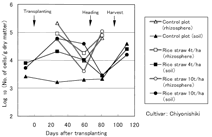Differences among rice cultivars in CH4 emission and populations of rhizospheric methanotrophic bacteria at the rice ripening stage
Description
[Objectives]
In lowland rice cultivation, rice plants grow under flooded conditions and CH4 is emitted from the fields. Controlling CH4 emissions from paddy fields is expected to contribute to the mitigation of global warming. Methanotrophic bacteria can utilize CH4 as their sole carbon and energy source and hence, they are considered to be important regulators of atmospheric CH4 fluxes. The objectives of this study were 1) to enumerate the populations of methanotrophic bacteria in rice rhizosphere and soil in a subtropical paddy field, and 2) to elucidate the differences among three rice cultivars (Chiyonishiki, Japonica rice; IR72, Indica rice; and IR65598, tropical Japonica rice) in terms of CH4 emission, CH4 oxidative activity in roots, and rhizospheric methanotrophic population at rice ripening stage.
[Results]
Methanotrophic bacteria in the genus Methylosinus (Fig. 1) were isolated from rice rhizospheres in a subtropical paddy field on Ishigaki Island in Okinawa Prefecture. (light clay soil; alluvial origin).
Fluctuations in population levels of methanotrophic bacteria in rice rhizospheres and soil with and without rice straw application at 4 and 10 t/ha (Fig. 2) shows that at the rice heading to ripening stages, the methanotrophic populations in rice rhizospheres increased to about 105/g dry matter, whereas the populations in soil concurrently declined to 3x103/g dry soil.
Table 1 shows that CH4 emission rate for IR65598 was significantly lower than in the other two cultivars at the ripening stage, while its CH4 oxidative activity in roots was the highest among the three cultivars. Furthermore, the methanotrophic population in roots in IR65598 was significantly higher than in the other two cultivars at the ripening stage.
From this study it was concluded that methanotrophic bacteria Methylosinus spp. inhabited rice rhizospheres in the subtropical fields used in this study, and it was also found that CH4 emission rates and methanotrophic populations in roots differed significantly among rice cultivars at the rice ripening stage.
Figure, table
-
Fig. 1. Photomicrographs of methanotrophic bacteria Methylosinus spp. isolated from rice rhizospheres in a subtropical paddy field. a: Strain R16; b: strain R18. The bar indicates 10 .
. -
Fig. 2. Fluctuations in population levels of methanotrophic bacteria in rice rhizospheres and soil with and without rice straw application at 4 and 10 t/ha in a subtropical paddy field. -
Table 1. CH4 emission rate, CH4 oxidative activity and methanotrophic population level in roots, and root dry weight of three rice cultivars at rice ripening stage (pot experiment, 1 plant pot-1).
Values are means of 3 replicates } SD (standard deviation). Data in column followed by the same letters are not significantly different.
- Affiliation
-
Japan International Research Center for Agricultural Sciences Okinawa Subtropical Station
- Classification
-
Technical A
- Term of research
-
FY2001 (FY1992-1999)
- Responsible researcher
-
ADACHI Katsuki ( Okinawa Subtropical Station )
NAKAMURA Ken ( Okinawa Subtropical Station )
WANG Bujun ( JIRCAS Visiting Research Fellowship Program )
DIANOU Dayeri ( JIRCAS Visiting Research Fellowship Program )
ESPIRITU Bayani M. ( JIRCAS Visiting Research Fellowship Program )
OYEDIRAN Gbade ( JIRCAS Visiting Research Fellowship Program )
CHAITEP Waree ( JIRCAS Visiting Research Fellowship Program )
SENBOKU Toshihiro ( Okinawa Subtropical Station )
- ほか
- Publication, etc.
-
D. Dianou and K. Adachi (1999):Characterization of methanotrophic bacteria isolated from a subtropical paddy field. FEMS Microbiol. Lett., 173, 163-173.
B. M. Espiritu, K. Adachi and T. Senboku (1997):Effect of application of rice straw and cellulose on methane emission and biological nitrogen fixation in a subtropical paddy field. III. Populations of methane-oxidizing bacteria in soil and rice rhizosphere. Soil Sci. Plant Nutr., 43, 729-734.
B. Wang and K. Adachi (2000): Differences among rice cultivars in root exudation, methane oxidation, and populations of methanogenic and methanotrophic bacteria in relation to methane emission. Nutr. Cycling Agroecosys., 58, 349-356.
- Japanese PDF
-
2001_26_A3_ja.pdf639.8 KB
- English PDF
-
2001_23_A4_en.pdf89.49 KB



